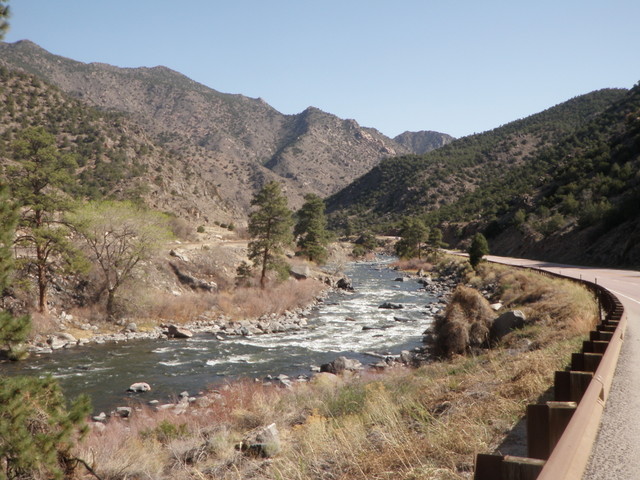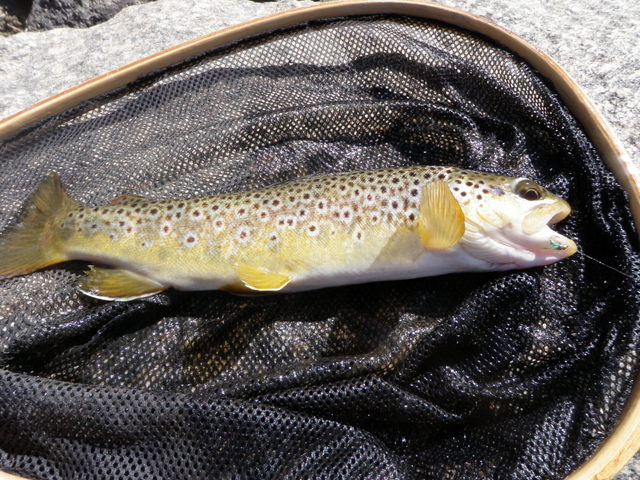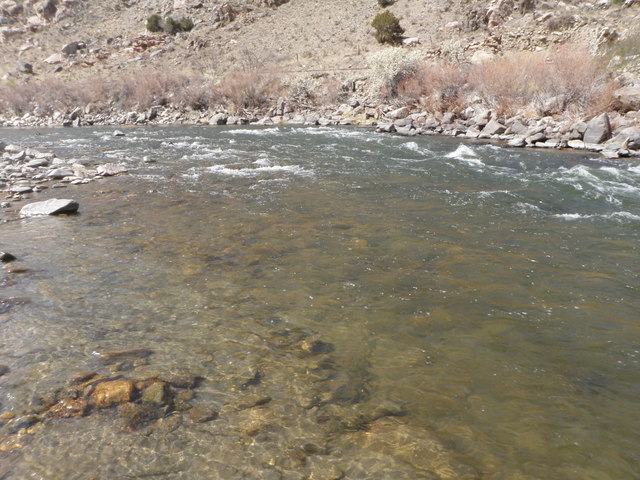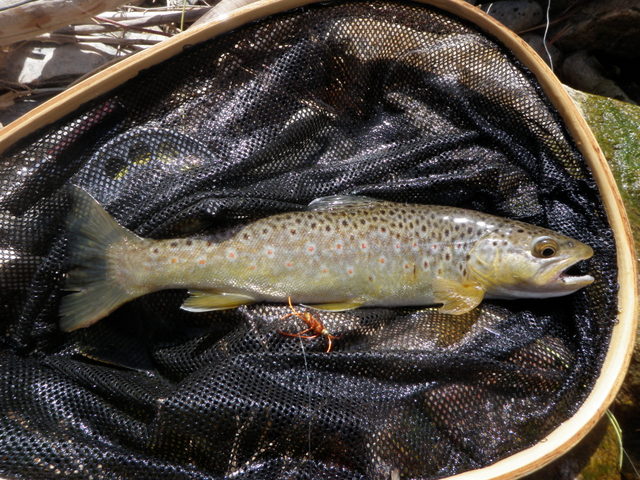Time: 10:00AM – 4:00PM
Location: 100 yards downstream from Spike Buck to above Spike Buck Access area
Fish Landed: 12
Arkansas River 04/06/2012 Photo Album
Do certain flies work better as a pair? Was a beadhead pheasant tail meant to be fished with a San Juan worm? Does an Arkansas rubber legs make a RS2 more effective?
Wind is one of the more difficult factors to deal with in the world of fly fishing. That’s exactly what came into play Friday, April 6 as I visited the Arkansas River. The Royal Gorge Angler web site reported that caddis began hatching in Canon City and the weather forecast called for high temperatures of 70+ degrees in Denver so I decided to make the trip.
I targeted the stretch of water below Spike Buck and planned to commence fishing where I’d ended my day on an earlier trip. Even though the hatch began in Canon City, I didn’t expect to see caddis hatching upstream where I was fishing, but one never knows. By 10AM I had parked opposite the entrance to the Spike Buck recreation access area and walked down the highway to a cluster of three pine trees where I carefully negotiated my way to the river. I immediately tied on an Arkansas rubber legs nymph that had served me well on my previous trip, and then added a bright green caddis pupa on the point. The rubberlegs was weighted so I didn’t need to add any split shot, but I did loop a thingamabobber to the leader a foot or two below the junction with the fly line.
I worked the water for a while but had no success so I clipped off the bright green caddis and tied on a beadhead hares ear. After covering a couple additional nice runs with no success, I moved to an emerald beadhead caddis pupa on the point. This brought some action and after hooking and losing a fish, I connected with another fish and landed it. The first landed brown of the day fell for the emerald caddis pupa. With new optimism I moved upstream and landed a second brown on the caddis pupa. But the next fish I hooked after sensing a pause to the indicator immediately made a run and dive under a large boulder in front of me. I tried to lift the flies by applying pressure up and forward, but nothing was moving and I couldn’t feel any pulsing through my rod. I waded over to the rock and saw a branch lodged across the front. Evidently the fish had wrapped me around the branch and broke off. Much to my dismay both flies were gone, so I took the time to patiently extend my leader, add two split shot and decided to go with a double caddis pupa offering. I placed the bright green caddis pupa on top and then added the emerald pupa to the end.
I moved upstream along the south bank casting the pair of caddis pupa and landed three more 9-11 inch brown trout. It was now noon so I decided to cut back to the highway directly across from a railroad bridge that ran along the opposite side of the river. I placed my rod and frontpack in the rear of the Santa Fe and grabbed my lunch bag and water bottle and walked down to the river across from the car. I perched on a large rock that protruded into the river and munched my lunch while observing, but I was seeing nothing of interest on the water. By now the wind velocity had increased with periodic gusts, and I had to keep my elbow on my lunch bag so it wouldn’t blow away while I ate with my other hand.
After lunch I grabbed my rod and returned to the spot across from the railroad bridge where I’d quit for lunch. I kept the two pupa on my line and worked my way upstream again. However, the wind was now gusting so hard that I had to pause and turn my back from time to time while waiting for the wind to subside to a breeze. Even with two split shot and an indicator, many casts were being blow back toward me. Fifteen foot casts became five foot casts much to my dismay.
I reached seven fish landed as I approached the stretch near where I’d eaten lunch and I’d experienced a long dry spell so I decided to change my approach. I did start to notice a very occasional blue wing olive in the slower eddies along the bank, so I moved the emerald caddis to the top position and added a beadhead RS2 beneath. But this didn’t seem to be working in spite of the sparse BWO hatch so I resorted to the recommended combination when caddis aren’t hatching. I clipped off the emerald caddis pupa and replaced with my version of the Arkansas rubber legs. My fly was constructed with yellow and brown variegated chenille and rust colored rubber legs. The length of the fly was a size 10 3XL; whereas, the purchased fly was close to a size 8 streamer hook, and my rubber legs were darker in color.
Is it possible that a synergistic effect exists between two flies even though only one of the flies is hooking fish? The emerald caddis and beadhead RS2 did not work, but the golden stonefly and beadhead RS2 proved deadly. Over the remainder of the afternoon I landed another five brown trout, and these fish were larger that any of the fish I caught in the morning and early afternoon. The weighted stonefly tended to lodge in the rocks in the more shallow riffles, but this is exactly the location where I hooked most of the fish. Two to three foot riffles and runs at the very top of the run were the most productive areas. I was absolutely amazed at the nice fish that spotted the tiny RS2 that was dangling a foot behind the large Arkansas rubber legs. Perhaps the large stonefly serves as an attractor, and then the trout spot the trailing RS2 and this is similar to the natural BWO nymphs present, so they grab it for an easy feast. Why would the same fly work with one fly but not with another?
I can only theorize, but I’ll continue to combine the Arkansas rubber legs with an RS2 on the Arkansas River.




